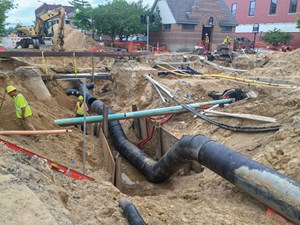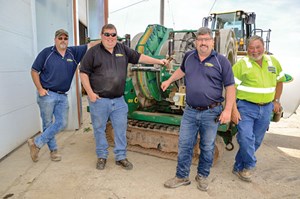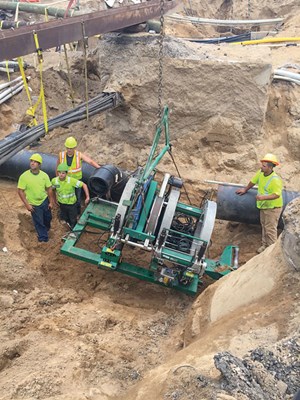March 2019 Vol. 74 No. 3
Features
Hard Work, Vision Bring Success to Great Lakes Fusion
Bryan Marks started working when he was only 8 years old. His job was to pick up the loose trash that had blown off the Venice Park Landfill his family owned in Lennon, Mich. By the time he was 10, he was running bulldozers, loaders and off-road trucks.
It seemed natural for him to be part of the operation since they did all their own construction, plus it was a great opportunity to learn a valuable skillset that would be helpful down the road. His late grandfather, Ralph Crawford, instilled a strong work ethic, and while he may not have fully appreciated it at the time, he’s very grateful for the experience.
As the owner of Great Lakes Fusion, Marks’ company specializes in all facets of landfill construction: excavation, drilling and HDPE pipe fusion services for pipe up to 65-inches and installation of methane and leachate collection systems. He’s also diversified by starting related companies Great Lakes Ready Mix, Great Lakes Rental & Supply and Great Lakes Machining & Fabrication, which makes HDPE specialty products.
Not surprisingly, Marks’ introduction to fusing HDPE pipe also came early in 1986 when he was just 14. The company was constructing a pipeline to collect methane from the landfill that would be used to power a cogeneration facility.
“My grandfather was always fascinated by new technologies and new advancements,” Marks said. “At that time, it was on the cutting edge. We were only the second landfill in the state of Michigan to ever do that.”
Adopting new innovations required unique equipment. McElroy fusion machines were selected early on and Marks has stuck with them ever since. He still has some McElroy equipment that is more than 30 years old, including the first fusion machine he ever used—a Rolling 28 for 2-to-8-inch HDPE pipe.
He finds the equipment easy to use and likes having the flexibility of removing the carriage from the chassis and placing it in a trench for in-ditch fusion.
All in the family
The company business came to a close in 1992, when it was bought out by a large international waste firm. While his grandfather, mother Jo Marks and uncle Rod Crawford moved on, Ric Crawford and Marks stayed with the new company. Shortly thereafter, Marks was promoted to operations manager for another landfill site in west Michigan. He also had his own pipe division within the company and was installing methane gas systems in-house until 1998.
At that time, his employer decided to outsource the pipe installation part of the business and that prompted an entrepreneurial spirit in Marks. He left the company and started his own excavation and pipeline construction company—Great Lakes Fusion.
It turned out to be a good decision for everyone involved. Great Lakes Fusion started as a subsidiary of his uncle Ric Crawford’s company, Lennon Construction. They were able to negotiate a deal with his previous employer to buy all its fusion equipment and immediately was hired as an independent contractor of the ex-employer to install methane gas recovery projects throughout Michigan.
“I worked under (Crawford’s) construction company and he mentored me over the next few years with the agreement that if, and when, I was ready to go off on my own, he would let me buy Great Lakes Fusion out. That’s what I did in 2001,” Marks said.
Crawford retired shortly after the buyout, but he became bored. “He said, ‘Have you got anything for me to do? I’ve got to have something to do.’ “Be careful what you wish for,” Marks quipped. “So, my uncle, who mentored me and trained me, is working for me now.”
But Marks still considers Crawford a mentor. “He runs any piece of equipment and can bid any job; age hasn’t slowed him down a bit,” Marks said.
His cousins also work at Great Lakes Fusion. Chad Crawford is chief financial officer, and Randy Crawford, the chief operating officer. Marks thinks of them as the pillars of the company. “They could run this place even if I wasn’t here,” Marks said.
Today, Great Lakes has over 40 fusion technicians on the job at any given time, working mostly at landfills, sewer and dewatering projects, primarily in Michigan, Ohio, Indiana, Illinois, Wisconsin, Pennsylvania, Kentucky and Tennessee. Every spring, ISCO Industries comes in to provide certified fusion training for new operators and re-certification for existing fusion crews.
Landfill expansions
Great Lakes has grown to become the preferred excavation and pipeline contractor for many landfills in the midwestern United States. Building new waste cells and drilling wells into newly de- posited trash to collect methane is one aspect of its ongoing work. As the landfill grows, the company must drill more wells, more lateral pipelines are added, and the larger mainlines must be extended.
One of the most-recent projects was a five-week gas expansion project to fuse a two-mile, 18-inch mainline that looped the circumference of the landfill. From the mainline, Great Lakes branched 4-, 6-, and 8-inch lateral piping up the mound of the landfill which connects to the gas wells. Once piped to a cogeneration facility, the methane turns giant generators that provide enough electricity to power over 5,500 homes.
Because of HDPE’s durability, chemical resistance and flexibility to withstand underground shifting, Marks said it is the ideal pipe material to use in landfills.
Being around landfills all his life, Marks’ company has discovered many ways to operate them more efficiently. GLF Lids are the perfect example. They were created in response to the difficulty workers were having in removing flanges from cell risers. This is a routine function at landfills so that leachate—the water that drains though the landfill—can be pumped out and treated at a waste treatment facility.
It was taking two people as long as an hour to remove each flange and each landfill could have 25 or more of them, so it was a time-consuming process. It required two large wrenches to remove the nuts and bolts, and those were easily lost and functioning poorly due to corrosion. The GLF lids were a great improvement because tools are not needed to remove them, and it only takes one person about 30 seconds. Being composed of HDPE, they provide an airtight and leak-free seal with the base fused to a manhole or slope riser pipe. Stainless steel “T” bolts and HDPE hand-torque nuts are used to attach the HDPE lid which protects them from corrosion. They are easily removed from the lid while staying permanently attached to the flange, so there are no loose parts. Great Lakes has been selling them to landfills across the country and in Canada for the past 15 years.
Last year, the company released another innovation—a patented Hard-Welded Dual Contained Sump, which is used to prevent methane condensation from leaking into the ground water. The sump consists of a 24-inch HDPE containment pipe, for example, inside a 36- inch leak detection pipe with a monitoring device situated in the space between the pipes. These come in various sizes— 48-inch within a 60-inch pipe, 12-inch within an 18-inch, etc. “We used to do an extrusion weld, but it wasn’t as strong, so we butt-fuse everything now. With HDPE, you have a leak-free joint that is as strong or stronger than the pipe itself. You should never have to replace this. We can make it any diameter up to 65-inch,” he said.
In the news
Not every project is a landfill. Marks’ company can provide pipe fusion services for other industries, including public works, where the ability to fuse pipe quickly can protect a neighborhood’s quality of life and personal property.
One example occurred on Christmas Eve in 2016. A large sewer pipe collapsed in Fraser, Mich., leaving behind a huge 250-by-100-foot sinkhole. Residents from more than 20 homes were evacuated and three homes were damaged beyond living condition.
To prevent the risk of further damage, Great Lakes was called to fuse emergency bypass lines so that the sewage could be pumped around the break while the collapsed pipe buried 55 feet in the ground was being repaired. All together, the GLF team fused 2½ miles of 32-inch and 48-inch HDPE pipe with a McElroy TracStar 900 and the largest machine, a MegaMc 2065. The bypass lines operated for eight months before the permanent line was fixed.
Marks’ grandfather didn’t live long enough to see his grandson launch Great Lakes and all the ways he would build upon his legacy, but it was his guidance that helped Marks build a strong foundation that has led to a remarkable career. His pointed advice has always stayed with Marks in every job he has ever worked.
Today he lives his grandfather’s words in his work, as well as his life: “You get out what you put in.” •
FOR MORE INFORMATION:
McElroy Manufacturing, (918) 836-8611, mcelroy.com
Great Lakes Fusion, (989) 288-
2656, greatlakesfusion.com







Comments